
My husband and I like to watch this show on German TV, where people bring their old stuff, get an appraisal, and then sell the things to antique dealers. A lot of the old stuff that is shown is actually beautiful jewelry, and as little as I wear any kind of adornment, I love to look at these old treasures. Or delicate bronze sculptures. Or lovely paintings with breathtaking frames. I’ve had it in the back of my mind to make some cookies inspired by that show for quite a while. Now I’ve finally dragged this idea to the front of my mind, and as I am rather satisfied with the outcome, I would like to share the result with you. [EDITOR'S NOTE: I'm more than satisfied with the outcome too! Wow! ![]() ]
]
- At least 1 (3 3/4-in/9.5-cm) hexagonal cookie
- Hexagonal cardboard templates, for border and "bronze" pattern (See attachments at the end of this post.)
- Food marker
- Piping bag with #3 round tip, or equivalent
- Light olive green flooding-consistency royal icing
- Scribe tool
- Large soft brush
- Ivory luster dust (i.e., Rainbow Dust Ivory Shimmer)
- Piping bags with #2 round tips, or equivalent
- Dark brown stiff flooding-consistency royal icing (SFCI)
- White stiff flooding-consistency icing (SFCI)
- Bronze luster dust (i.e., Rainbow Dust Metallic Ginger Glow)
- Clear extract
- Soft brush #2/0
- #1 round tip
- Lilac luster dust (i.e., Rainbow Dust Starlight Lunar Lilac)
Start by marking the border on as many cookies as you want with the hexagonal border template (1). You can use either of the two attached border templates, but I found it easier to work with the version with one arc cut out of one side (as opposed to the one with six cut-out arcs). It allowed me to more flexibly adjust to small variations in actual cookie shape. Align the curved side of the template with two corners of the cookie, and trace along the curved edge (or arc) with a food marker (2).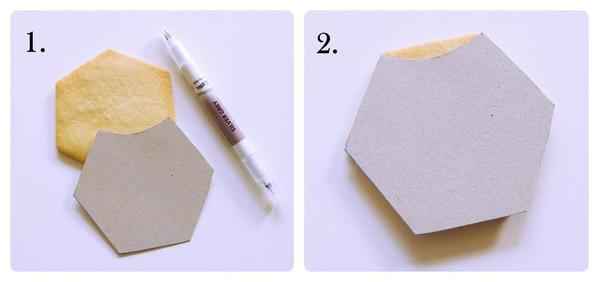 Rotate the template, and repeat the process for the other five sides (3). Fill a piping bag fitted with a #3 tip (or equivalent) with light olive green flooding-consistency royal icing, and flood the cookie within the scalloped border that you drew in Step 2. Use a scribe tool to shape the icing where necessary, to "tease" it into the sharp points, and to help neaten the edges (4). Let the cookie dry thoroughly, ideally overnight.
Rotate the template, and repeat the process for the other five sides (3). Fill a piping bag fitted with a #3 tip (or equivalent) with light olive green flooding-consistency royal icing, and flood the cookie within the scalloped border that you drew in Step 2. Use a scribe tool to shape the icing where necessary, to "tease" it into the sharp points, and to help neaten the edges (4). Let the cookie dry thoroughly, ideally overnight. Using a large soft brush, apply a generous amount of ivory luster dust to the surface of the dry iced cookie (5). Gently rub the powder into the surface until you have achieved a visible sheen (6).
Using a large soft brush, apply a generous amount of ivory luster dust to the surface of the dry iced cookie (5). Gently rub the powder into the surface until you have achieved a visible sheen (6).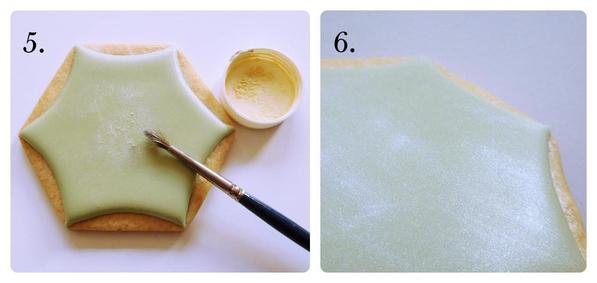 Now mark the pattern for the "bronze" details on the surface of the cookie. I did the marking freehand, scratching the lines with a scribe tool, and following the attached template as a visual guideline only (7). But you can choose any means you like to transfer the outlines onto your icing. (One of @Dolce Sentire - Aixa Zunino's past Cookie Connection tutorials describes an easy paper transfer method. Check it out here.)
Now mark the pattern for the "bronze" details on the surface of the cookie. I did the marking freehand, scratching the lines with a scribe tool, and following the attached template as a visual guideline only (7). But you can choose any means you like to transfer the outlines onto your icing. (One of @Dolce Sentire - Aixa Zunino's past Cookie Connection tutorials describes an easy paper transfer method. Check it out here.)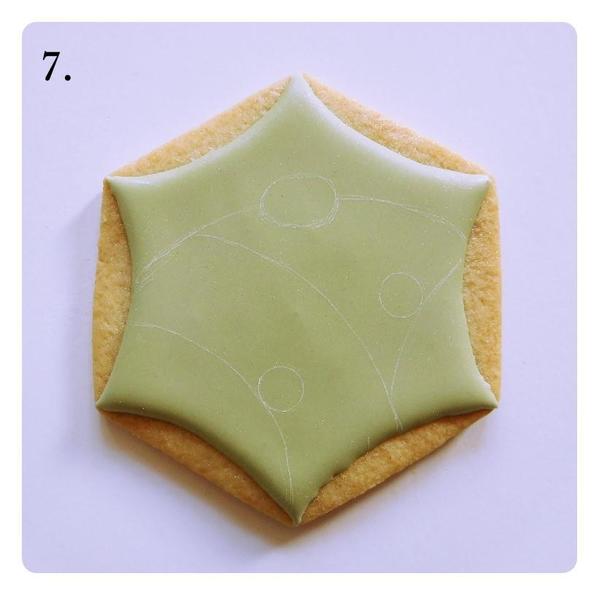 Fit a piping bag with a #2 tip (or equivalent), and fill it with dark brown stiff flooding-consistency (SFCI) royal icing. The consistency is right when the icing doesn’t smooth out entirely on its own, but can still be smoothed with the help of a scribe tool.
Fit a piping bag with a #2 tip (or equivalent), and fill it with dark brown stiff flooding-consistency (SFCI) royal icing. The consistency is right when the icing doesn’t smooth out entirely on its own, but can still be smoothed with the help of a scribe tool.
Pipe over the pattern you applied in the previous step (8). Allow a little drying time (i.e., a few minutes); then pipe small leaves on both sides of each line, shaping them with the scribe tool (9). Now, for the beaded border! Start by piping small circles, on each curved edge, in the middle of the open space between the cookie edge and the icing (10); then add three beads on both sides of each circle, starting with a large bead next to the circle and making each successive bead smaller (11). To keep the beads distinct, allow a few minutes of drying time between each bead.
Now, for the beaded border! Start by piping small circles, on each curved edge, in the middle of the open space between the cookie edge and the icing (10); then add three beads on both sides of each circle, starting with a large bead next to the circle and making each successive bead smaller (11). To keep the beads distinct, allow a few minutes of drying time between each bead. The large moonstones follow next. Fill a piping bag fitted with a #2 tip (or equivalent) with white SFCI. Fill the open spaces in the pattern with a copious amount of icing in order to create dimension (12). Let the icing crust sufficiently, about 15 minutes, so that it will be firm enough for painting in the next step.
The large moonstones follow next. Fill a piping bag fitted with a #2 tip (or equivalent) with white SFCI. Fill the open spaces in the pattern with a copious amount of icing in order to create dimension (12). Let the icing crust sufficiently, about 15 minutes, so that it will be firm enough for painting in the next step.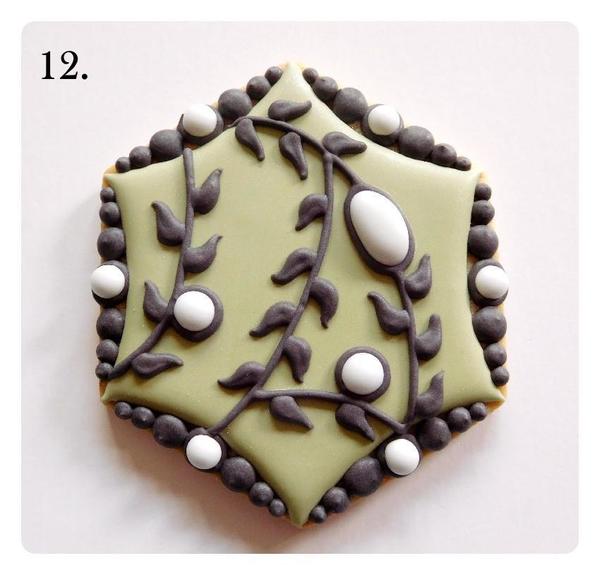 We'll start with painting the "bronze" (or brown) areas of the pattern. Mix some bronze luster dust with clear extract of your choice. The mixture should be on the thin side, not a thick paste that covers the color of the icing. We want some of the brown to show through! Using a #2/0 brush, apply the bronze paint to the brown icing using uneven strokes (13). Try to avoid the white moonstones!
We'll start with painting the "bronze" (or brown) areas of the pattern. Mix some bronze luster dust with clear extract of your choice. The mixture should be on the thin side, not a thick paste that covers the color of the icing. We want some of the brown to show through! Using a #2/0 brush, apply the bronze paint to the brown icing using uneven strokes (13). Try to avoid the white moonstones!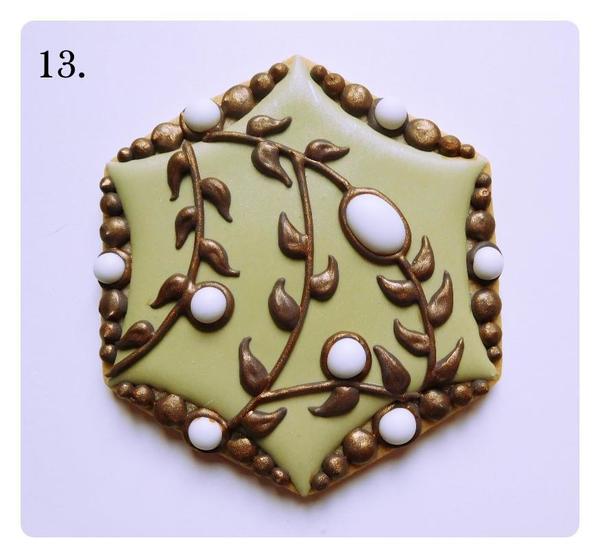 Return to the white SFCI, but swap out the #2 tip for a smaller #1 tip. Complete the design by adding a ring of tiny dots around the large oval moonstone, and small white dots in each corner of the cookie (14). When the white icing is dry enough, it’s time for the finishing touches. Clean the #2/0 brush thoroughly, and mix some lilac luster dust with clear extract. Again, thin it to a watery consistency. The paint should just add a shimmer to the white icing, not cover it. Apply a thin coat to the white moonstones (15), and let the paint dry. Done!
Return to the white SFCI, but swap out the #2 tip for a smaller #1 tip. Complete the design by adding a ring of tiny dots around the large oval moonstone, and small white dots in each corner of the cookie (14). When the white icing is dry enough, it’s time for the finishing touches. Clean the #2/0 brush thoroughly, and mix some lilac luster dust with clear extract. Again, thin it to a watery consistency. The paint should just add a shimmer to the white icing, not cover it. Apply a thin coat to the white moonstones (15), and let the paint dry. Done!
 A couple of these cookies will work for almost any occasion – coffee with friends, party favors, or just for yourself!
A couple of these cookies will work for almost any occasion – coffee with friends, party favors, or just for yourself! ![]() [EDITOR'S NOTE: Ooh, I think these cookies would look just fab on my dining room table at Christmas! I typically do it all up in soft green and gold with the sparkle of vintage ornaments and crystals.]
[EDITOR'S NOTE: Ooh, I think these cookies would look just fab on my dining room table at Christmas! I typically do it all up in soft green and gold with the sparkle of vintage ornaments and crystals.]
P.S. Again, all of my templates can be found in the attachments at the very end of this post.

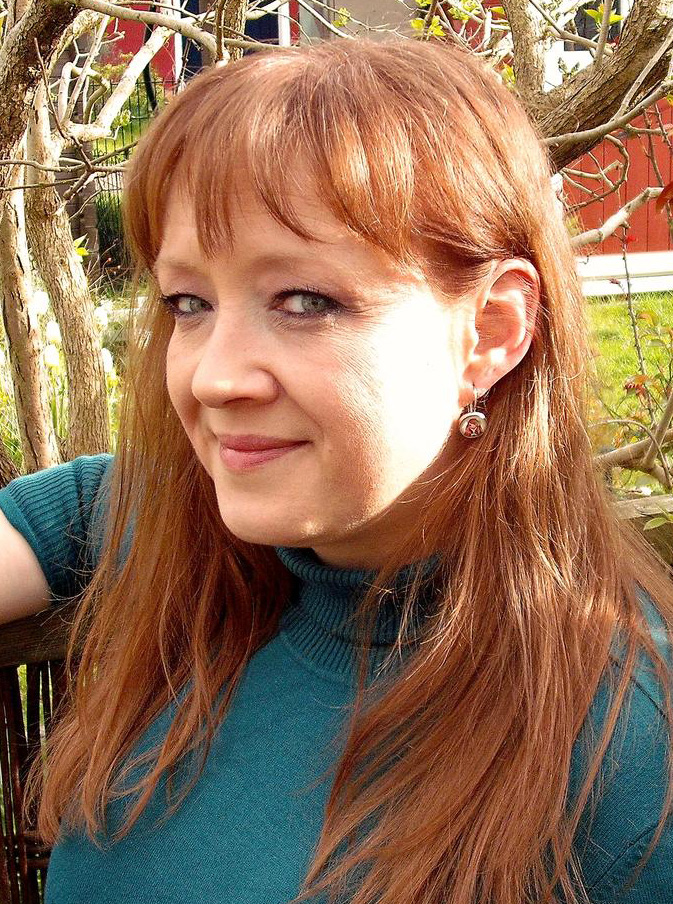 Leoni Eckart, aka Laegwen, started her baking career way before her own memory sets in, decorating Christmas cookies with her mother (at least that's what she's been told!), and has never entirely stopped puttering around in the kitchen since. Her first decorated cookies as an adult were her own wedding favors, and then, over Christmas 2014, her cookie fever went into overdrive! As of present, it shows no signs of cooling off. You can find Leoni on Facebook here, or you can reach her by email at laegwen@outlook.de.
Leoni Eckart, aka Laegwen, started her baking career way before her own memory sets in, decorating Christmas cookies with her mother (at least that's what she's been told!), and has never entirely stopped puttering around in the kitchen since. Her first decorated cookies as an adult were her own wedding favors, and then, over Christmas 2014, her cookie fever went into overdrive! As of present, it shows no signs of cooling off. You can find Leoni on Facebook here, or you can reach her by email at laegwen@outlook.de.
Photo credit: Leoni Eckart
Note: Get Inspired with Laegwen is a bimonthly series of cookie decorating tutorials that follow Leoni Eckart's personal experiments with gumpaste, royal icing, and other cookie decorating materials and methods. This article expresses the views of the author, and not necessarily those of this site, its owners, its administrators, or its employees. To read all of Leoni's past Get Inspired tutorials, click here. And to catch all of our Cookie Connection tutorials, click here.

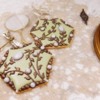
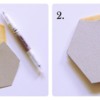

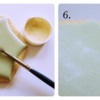
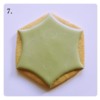


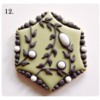

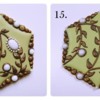
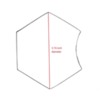

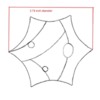
Comments (21)